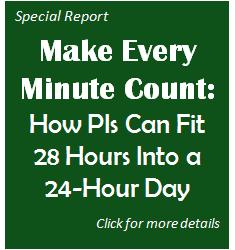|
Sep 13
2010
|
No. 45: Are There Certain Times of the Year When It’s More Advantageous to Submit a Proposal for Funding?Posted by: PIA in Tagged in: Untagged
|
|
Sign Up to receive free weekly articles like these
GRANTS & FUNDING
Are There Certain Times of the Year When It’s More Advantageous to Submit a Proposal for Funding?
Reader Question: I'm about ready to submit my first grant application, and I'm concerned about the fierce competition. A colleague tells me I might have a better chance if I wait until right before the coming holidays because there are fewer applications then. Is she correct? Are one's chances of success really better at certain times of the year?
Expert Comments: The stock answer from the National Institutes of Health and other granting agencies is that the timing of the submission of your proposal should be driven by the quality of the science — not on the basis of perceived differences in the success rate as a function of the grant cycle.
An outstanding proposal will always attract strong consideration for funding no matter what time of the year it is received, while a fundamentally weak one likely will go unfunded, regardless of its submit time in the cycle.
So you should submit your application as soon as your ideas are fully developed, capable of being clearly presented, and well supported by convincing preliminary data.
That being said, for grants that score near the percentile cutoff between funded and non-funded, timing can make difference. One is unlikely to achieve a substantially better success rate by trying to “game the system,” but it can be helpful to understand how the budget and grant submission cycles relate, particularly with regard to understanding that different submission dates might be associated with different time intervals to a final decision for funding from a given institute.
All principal investigators should be aware that there are three distinct NIH submission and review cycles in a given fiscal year: Cycle I (new RO1 due Feb. 5), Cycle II (new RO1 due date June 5), and Cycle III (new RO1 due date Oct. 5). Scientific review typically occurs four to five months after the receipt date, with Advisory Council review occurring approximately three months after the initial review group.
Awards take another few months to process once council has met. Against the backdrop of the Submission and Review cycle is the NIH fiscal year, which formally starts Oct. 1.
However, Congress rarely completes the appropriation process on time, meaning that NIH and other government agencies often are compelled to operate into the next calendar year under a “continuing resolution,” which constitutes the stop-gap measure of using the previous year’s budget as an estimate.
Until the various institutes receive their actual year’s budget, they may operate using “provisional” paylines, funding only the very best grants and holding many good grants in the “fundable” pile until the budget is approved.
Accordingly, if your grant receives a score that is near the payline, your decisions about whether a revised proposal should be submitted could be influenced by which cycle you are in, and whether the institute has an actual budget for the fiscal year.
The National Institutes for Allergies and Infectious Diseases (NIAID) has a nice table that explains how timing issues impact funding and resubmission decisions. (While this applies to NIAID, I think it may be generalized to other institutes.)
Applications submitted in Cycle 1 have the disadvantage that they make it through Initial Review and Council before the fiscal year starts in Oct. 1, so if your score is less than stellar you will likely have to wait until the following spring to get a clear funding decision. One advantage of this cycle is that you will get your reviews in time for a submission in Cycle 3 (Oct. 5 deadline), which means that your revised grant has the opportunity to get funded in the same fiscal year.
If your grant is submitted in Cycle 2, you may have a shorter time interval to a firm funding decision because a budget will be in place by the time council review occurs. However, if a resubmission is necessary, you’ll have to go in at Cycle 1 of the next fiscal year (see above).
Cycle 3 has the clear advantage that, once you get the score, the institute payline (unless you are in the National Institute of General Medical Science) may have been established, giving you a clear picture on likely success. If the grant has to be resubmitted, it would go in at Cycle 2 of the following fiscal year.
As noted above, any decisions about resubmissions should be driven by the science, and the time required to generate a significantly improved application. With the limited number of resubmissions now available, every grant submitted should be the best you can produce: there is really no leeway anymore, and a half-developed idea merely to solicit feedback from reviewers is really counterproductive.
Expert Comments by Christopher Francklyn, PhD
Christopher Francklyn, PhD, is a former study section chair and veteran reviewer for NIH and NSF study sections. He is a professor at the University of Vermont.
Chris Francklyn is the monthly columnist of Study Section Insider in thePrincipal Investigator Advisor newsletter. Francklyn recently authored the featured article, "Review Emphasis Shifting from ‘Impact’ to ‘Innovation’". Download a free copy of Principal Investigator Advisor.
This eAlert is brought to you as an informational training tool by the Principal Investigators Association, which is an independent organization. Neither the eAlert nor its contents have any connection with the National Institutes of Health (NIH) or the National Science Foundation (NSF), nor are they endorsed by these agencies. All views expressed are those personally held by the author and are not official government policies or opinions.
written by ml, September 09, 2010
written by Observer, September 13, 2010
Top finds
- Casino Non Aams
- Migliori Slot Online
- Casino Not On Gamstop
- Casino Not On Gamstop
- Migliori Casino Online Italia
- Non Gamstop Casinos UK
- Best Non Gamstop Casinos
- Non Gamstop Casino Sites UK
- Non Gamstop Casinos
- Sites Not On Gamstop
- Betting Sites Not On Gamstop UK
- Best Online Casino Canada
- オンラインカジノ
- Real Poker Online
- Slots Not On Gamstop
- Non Gamstop Casinos
- Non Gamstop Casino Sites UK
- UK Casino Sites Not On Gamstop
- Slots Not On Gamstop
- Non Gamstop Casino Sites UK
- Casino Sites Not On Gamstop
- Meilleur Casino En Ligne
- UK Casino Not On Gamstop
- Best Betting Sites Not On Gamstop
- Migliori Casino Non Aams
- Meilleur Casino En Ligne Belgique
- Migliori Casino Online Esteri
- Casino En Ligne 2026



